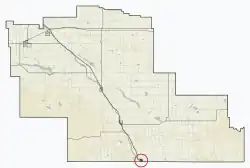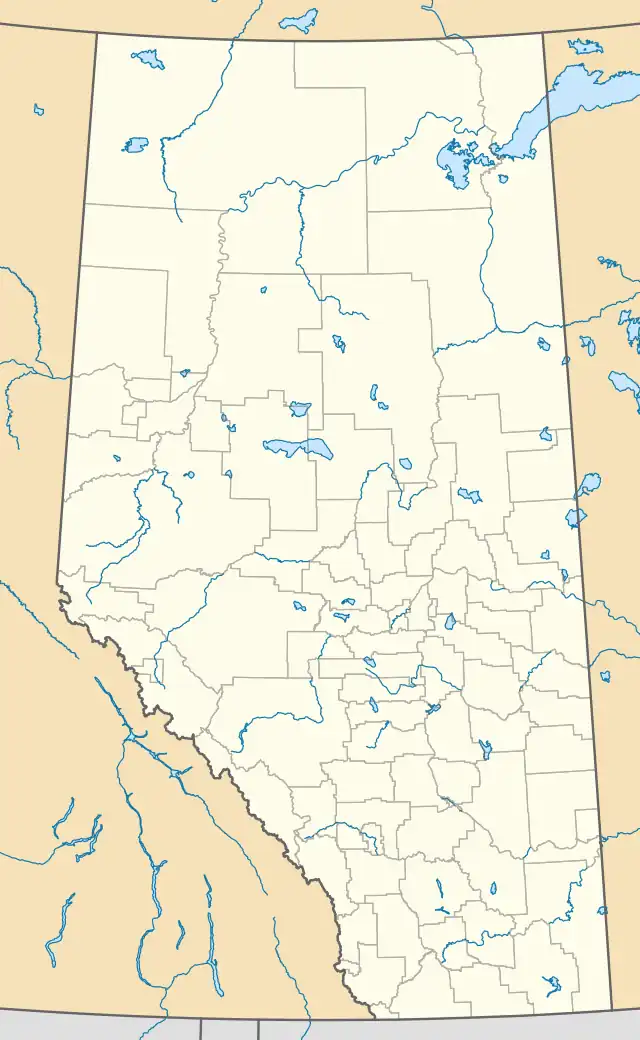Coutts | |
|---|---|
| Village of Coutts | |
 Coutts border crossing, into the US | |
| Motto: The Gateway to Alberta | |
 Location within County of Warner | |
 Location in Alberta | |
| Coordinates: 49°00′23″N 111°57′51″W / 49.00639°N 111.96417°W | |
| Country | Canada |
| Province | Alberta |
| Region | Southern Alberta |
| Planning region | South Saskatchewan |
| Municipal district | Warner |
| Incorporated[1] | |
| • Village | January 1, 1960 |
| Government | |
| • Mayor | Jim Willett |
| • Governing body | Coutts Village Council |
| Area (2021)[2] | |
| • Land | 1.18 km2 (0.46 sq mi) |
| Elevation | 1,070 m (3,510 ft) |
| Population (2021)[2] | |
| • Total | 224 |
| • Density | 190.4/km2 (493/sq mi) |
| Time zone | UTC−7 (MST) |
| • Summer (DST) | UTC−6 (MDT) |
| Area code | 403 / 587 |
| Highways | |
| Waterway | Milk River |
| Website | Official website |
Coutts (/ˈkuːts/ KOOTS) is a village in southern Alberta, Canada that is a port of entry into the U.S. state of Montana.[3] It is one of the busiest ports of entry on the Canada–United States border in western Canada. It connects Highway 4 to Interstate 15, an important trade route (CANAMEX Corridor) between Alberta, American states along I-15, and Mexico.
The community has the name of William Burdett-Coutts, a railroad official.[4]
In 2004, a joint border facility opened in Coutts–Sweet Grass, Montana, housing both Canadian and American federal authorities.[5]
History
In February 2022, four men were arrested on allegations that they conspired to kill Royal Canadian Mounted Police (RCMP) officers.[6] The arrests occurred during the Canada convoy protest in Coutts.[6] According to police, the plot was part of a wider plan to alter "Canada's political, justice and medical systems."[6] In December 2022, Coutts was described by CTV News as a "village divided" as residents identified as supporting or opposing the protest earlier that year.[7]
Demographics
In the 2021 Census of Population conducted by Statistics Canada, the Village of Coutts had a population of 224 living in 112 of its 152 total private dwellings, a change of -8.6% from its 2016 population of 245. With a land area of 1.18 km2 (0.46 sq mi), it had a population density of 189.8/km2 (491.7/sq mi) in 2021.[2]
In the 2016 Census of Population conducted by Statistics Canada, the Village of Coutts recorded a population of 245 living in 122 of its 159 total private dwellings, a change of -11.6% from its 2011 population of 277. With a land area of 1.24 km2 (0.48 sq mi), it had a population density of 197.6/km2 (511.7/sq mi) in 2016.[11]
See also
References
- ↑ "Location and History Profile: Village of Coutts" (PDF). Alberta Municipal Affairs. October 14, 2016. p. 190. Retrieved October 17, 2016.
- 1 2 3 "Population and dwelling counts: Canada, provinces and territories, and census subdivisions (municipalities)". Statistics Canada. February 9, 2022. Retrieved February 9, 2022.
- ↑ Your Official Road Map of Alberta (Map). Alberta Tourism, Parks and Recreation. 2014.
- ↑ Place-names of Alberta. Ottawa: Geographic Board of Canada. 1928. p. 38.
- ↑ Coutts-Sweetgrass border facility
- 1 2 3 Martin, Kevin (30 Nov 2022). "Some Coutts protesters wanted to alter Canada's political system, court documents say". calgaryherald. Retrieved 2022-12-02.
- ↑ "'One side or the other': Coutts, Alta. still a village divided after convoy blockade". Calgary. 2022-12-18. Retrieved 2022-12-18.
- ↑ "Population and Dwelling Counts, for Canada, Provinces and Territories, and Census Divisions, 2001 and 1996 Censuses – 100% Data (Alberta)". Statistics Canada. Retrieved 2012-04-02.
- ↑ "Population and dwelling counts, for Canada, provinces and territories, and census subdivisions (municipalities), 2006 and 2001 censuses – 100% data (Alberta)". Statistics Canada. 2010-01-06. Retrieved 2012-04-02.
- ↑ "Population and dwelling counts, for Canada, provinces and territories, and census subdivisions (municipalities), 2011 and 2006 censuses (Alberta)". Statistics Canada. 2012-02-08. Retrieved 2012-02-08.
- 1 2 "Population and dwelling counts, for Canada, provinces and territories, and census subdivisions (municipalities), 2016 and 2011 censuses – 100% data (Alberta)". Statistics Canada. February 8, 2017. Retrieved February 8, 2017.